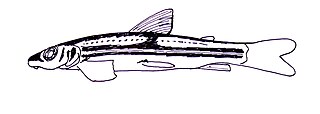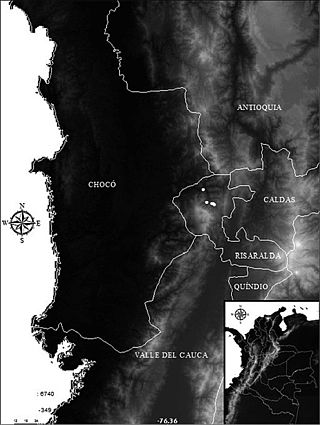
Characidae, the characids or characins is a family of freshwater subtropical and tropical fish, belonging to the order Characiformes. The name "characins" is the historical one, but scientists today tend to prefer "characids" to reflect their status as a by and large monophyletic group at family rank. To arrive there, this family has undergone much systematic and taxonomic change. Among those fishes that remain in the Characidae for the time being are the tetras, comprising the very similar genera Hemigrammus and Hyphessobrycon, as well as a few related forms such as the cave and neon tetras. Fish of this family are important as food and also include popular aquarium fish species.

The Magdalena River is the main river of Colombia, flowing northward about 1,528 kilometres (949 mi) through the western half of the country. It takes its name from the biblical figure Mary Magdalene. It is navigable through much of its lower reaches, in spite of the shifting sand bars at the mouth of its delta, as far as Honda, at the downstream base of its rapids. It flows through the Magdalena River Valley.

Hyphessobrycon is a genus of freshwater fish in the family Characidae. These species are among the fishes known as tetras. The genus is distributed in the Neotropical realm from southern Mexico to Río de la Plata in Argentina. Many of these species are native to South America; about six species are from Central America and a single species, H. compressus is from southern Mexico.

Astyanax is a genus of freshwater fish in the family Characidae of the order Characiformes. Some of these fish, like many of their relatives, are kept as aquarium pets and known collectively as tetras. With around 150 described species and new ones being described yearly, this genus is among the largest of the entire order; Hyphessobrycon also has more than 145 species and which one is larger at any one time depends on whether more species have been recently described in one or the other. The blind and colorless cave tetra of Mexico is a famous member of the genus, but its taxonomic position is disputed: Some recognize it as part of the Mexican tetra and this is supported by phylogenetic evidence, but others recognize the cave form as a separate species, A. jordani.

Argopleura is a genus of characins endemic to Colombia.

Bryconamericus is a genus of characins found in Central and South America.
Ceratobranchia is a genus of characins found in tropical South America.

Creagrutus is a genus of characins found mostly in South America, with one species C. affinis extending into Panama in Central America.

Gephyrocharax is a genus of characins found in South America, Trinidad in the Caribbean, and Panama.

Hemibrycon is a genus of characins. They are mainly found in South America, Trinidad in the Caribbean), and H. dariensis of east Panama.
Knodus is a genus of characins, small freshwater fish from South America.
Microgenys is a genus of characins from tropical South America.
Piabarchus is a genus of characins from tropical South America.
Pseudocorynopoma is a genus of characins from tropical South America.
Tyttocharax is a genus of characins found in tropical South America.

Parodon is a genus of scrapetooths from South America, which can be found as far south as Río de la Plata.

Hemibrycon sanjuanensis is a species of characin from the upper San Juan River, Colombia.

Carlastyanax aurocaudatus is a small species of freshwater fish in the family Characidae native to the Río Cauca in Colombia. It is the only member of the monotypic genus Carlastyanax, which was named in 1972 specifically for the species by Jacques Géry. Upon description, it was named Astyanax aurocaudatus by Carl H. Eigenmann. There has been debate concerning whether or not the genus should be recognized, but C. aurocaudatus is currently considered a valid species.
Hyphessobrycon chocoensis is a species of South American tetra, belonging to the family Characidae. It is pale orange in coloration. It has a very thin and dark midline beginning at the base of the caudal fin and fading back to pale orange before it reaches the gills. It is around 4 centimeters in length. It is known to inhabit the Telembí River Basin in Colombia. This fish is benthopelagic, meaning that it resides away from the surface of the water.

Iguanodectidae is a family of freshwater fish in the order Characiformes that lives in South America. It is home to the subfamily Iguanodectinae and the monotypic Bryconops clade. Several species in the family, such as the green line lizard tetra, the tailspot tetra, and the orangefin tetra, are sometimes taken as aquarium fish.












